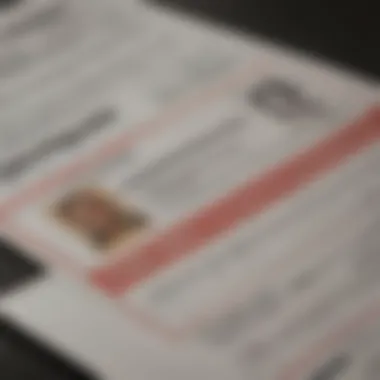Convenient Methods to Cash a Wells Fargo Check


Intro
Navigating the process of cashing a check can often lead to questions, especially when it involves specific banks like Wells Fargo. Understanding the available avenues for cashing a Wells Fargo check can enhance convenience and ensure a smooth transaction, whether you're a bank account holder or not. In this article, we will dissect the various methods for cashing a Wells Fargo check while clarifying the vital details that accompany each option.
Overview of the Topic
Cashing a check is a routine operation in personal finance, yet it has nuances that can vary dramatically based on factors like bank policies and customer status. The primary concern is ensuring you have a secure and effortless method to access your funds. A Wells Fargo check, specifically, may seem straightforward, yet there are various implications that come with the task.
Definition and Importance of the Topic
A Wells Fargo check represents a request for payment from the bank on behalf of the issuer. Understanding how to cash it properly can impact your financial management drastically, as it could include potential fees and specific identification requirements. This knowledge is important, as it can save you both time and money.
Key Benefits and Implications
- Accessibility – Knowledge of locations allows quicker access to funds.
- Flexibility – Several alternative methods cater to both account holders and non-account holders.
- Cost-effective – Being aware of associated fees helps to retain more earnings.
With these considerations in mind, we can now delve into effective strategies for cashing your check efficiently, aiming also to enhance your financial oversight.
Exploring Strategies and Tips
When planning to cash a Wells Fargo check, consider the following strategies and practical tips that can ease the process:
- Bring valid identification. A government-issued ID is typically required.
- Check Wells Fargo’s operating hours beforehand to find a suitable time for visit.
- Be mindful of additional fees, which can differ based on your customer status.
If you do not have a bank account with Wells Fargo, reliable choices might include cashing at a check cashing location, but approach these with cautions about high fees. Also, directly inquiring at the counter might yield more info regarding the transaction.
Remember that if you possess a Wells Fargo account, more options become available, often at lower costs.
Case Studies and Examples
Examining the experiences of others can impart valuable lessons about this process. Consider Jane, a Wells Fargo customer who decided to cash her check directly at her bank. She arrived with her identification and did not encounter any fees. It was an effective use of funds. Conversely, Tim, who did not hold an account, attempted to cash his check at a general check casher and faced high fees that diminished his payout significantly.
Learning from these examples can clarify the importance of knowing your banking status, estimating fees, and finding practical solutions.
Comparison of Payment Options
To boost your decision-making, compare different ways to cash a Wells Fargo check:
- Wells Fargo Bank Branch
Pros: No fees for accountholders, secure.
Cons: Limited operating hours. - Check Cashing Services
Pros: Cash available almost immediately.
Cons: Higher fees and minimum service charges.
By weighing the pros and cons of each option only, a clear picture of how to manage your funds emerges.
Expert Insights and Recommendations
Financial experts suggest prioritizing transactions at official institutions. Wells Fargo representatives often provide exact information you might need. Additionally, it's prudent to be organized. Until you know the fees attached, consider budgeting your cashing sessions to avoid any unexpected deductions.
Preamble
Cashing a Wells Fargo check is an essential skill for many individuals, whether they hold an account with the bank or not. It is important to understand the various options available, as they streamline this routine transaction. In this article, we will discuss the nuances of cashing a Wells Fargo check and the considerations surrounding it.
Checks remain a prevalent method of transaction in today’s world, despite the growing importance of digital payments. Understanding how to effectively cash a check can significantly impact your financial efficiency. There are different methods to consider, each with its own benefits and possible drawbacks.
Being informed on these options not only allows quicker access to funds but ensures that individuals are aware of any potential fees that might arise, particularly for non-account holders. Identifying the required documents and understanding each method’s nuances can contribute to a hassle-free experience.
In a practical sense, knowing where to cash your check can save time and reduce frustration. If you hash those factors together and consider user convenience, the reopened conversations offer actionable insights into tailored solutions for your financial engagements.
Before extending into further intricacies, it is necessary to clarify these facets accurately. Throughout the sections below, we will delve into the specifics concerning check types, various options for cashing one, necessary identification, and potential pitfalls. Expect ultimate clarity that can lead to more informed financial decisions.


Understanding Wells Fargo Checks
Understanding Wells Fargo checks is crucial for anyone who plans to cash one, as it encompasses key elements necessary for a successful transaction. A firm grasp of this topic not only ensures compliance with banking rules but also enhances the overall experience of handling your finances. Familiarity with the different types of Wells Fargo checks enables account holders and non-account holders alike to strategize the most efficient routes for cashing these instruments, while also considering security features that protect against fraud.
In this section, we will delve into two significant subtopics. First, we will outline the various types of Wells Fargo checks that users may encounter. This information is particularly beneficial for understanding which specific documents can be processed and how they might differ depending on the purpose. Next, we will examine check security features, integral to distinguishing authentic checks from potential forgeries.
This knowledge aids in eliminating confusion and increases confidence during cashing transactions, ensuring that individuals can navigate these processes smoothly without unexpected complications.
Types of Wells Fargo Checks
Wells Fargo issues several types of checks that serve various situations. Understanding these checks helps in deciding which type aligns best with individual needs:
- Personal Checks: Commonly issued by account holders, these checks draw funds directly from a personal bank account. They are most useful for everyday transactions.
- Cashier's Checks: These checks are purchased directly from Wells Fargo and represent guaranteed funds. Cashier's checks are often preferred for large transactions due to their security.
- Certified Checks: These resemble personal checks but are verified and backed by the bank, ensuring that funds are available at the time they are issued.
- Money Orders: This is yet another alternative provided by Wells Fargo for secure payments, especially for those who may not have a bank account.
Familiarizing oneself with these distinctions can prevent potential headaches down the line, aiding individuals in selecting the proper check type for cashing.
Check Security Features
Security features on Wells Fargo checks play an essential role in ensuring the safety of transactions. Being able to recognize these features aids account holders and cashing service providers in confirming authenticity. Key security features often included in Wells Fargo checks are:
- Watermarks: Authentic checks often contain watermarks that are visible when held up to light, providing a physical means of verification.
- Microprint: Tiny text or patterns often appear on checks to limit counterfeiting. This feature is challenging to replicate accurately, being a formidable barrier against fraud.
- Color-Shifting Ink: Some Wells Fargo checks might use ink that changes color when tilted, strengthening the check's resistance to forgery.
- Routed Numbers: A combination of symbols and numbers authenticate the check. These elements, along with embedded security threads, serve as proof that the check is not compromised.
The recognition of these security features significantly diminishes the risk of accepting counterfeit checks.
By knowing these details, individuals can better protect themselves from potential fraud, making the process of cashing checks more secure and efficient.
Eligibility to Cash a Wells Fargo Check
Understanding eligibility for cashing a Wells Fargo check is critical for an efficient experience. Some factors can influence whether you can cash a check without complications. Account status, identification, and the location where you plan to cash the check can affect the process. This section outlines what specific elements you need to meet for a successful transaction.
Requirements for Wells Fargo Account Holders
If you hold an account with Wells Fargo, cashing your check is generally straightforward. You benefit from having your identification easily validated.
Essential requirements include:
- A valid form of identification. This may be a government-issued ID like a driver's license or passport.
- The account must be in good standing. Ensure that there are no issues like overdrafts or negative balances.
- Endorse the check securely. Make sure to sign on the back, as the bank requires this.
By meeting these criteria, you expedite the process. The staff easily verify your identity. It allows for quicker access to your funds. In many instances, bank personnel might provide personalized assistance in any inquiry you may have.
Requirements for Non-Account Holders
For individuals who do not hold a Wells Fargo account, cashing a check involves different set of requirements. It’s important to be prepared to fulfill them to avoid any delays.
Expectations include:
- Valid identification: As with account holders, a government-issued ID is crucial.
- Check information verification: Non-account holders might undergo more scrutiny. Banks may verify the check amount and its validity before authorizing the cashing process.
- Potential Fees: Additional charges might apply since you're not a customer of the bank. Fees for non-account holders vary. Thus, it’s prudent to be briefed on this aspect beforehand.
People unfamiliar with the process may face hurdles, yet it is entirely feasible with the right preparation. Ensuring all applicable information is ready will make your experience smoother.
Remember, carrying a detailed understanding of these requirements aids all parties involved, facilitating a clearer and more efficient cashing process.
Options for Cashing a Wells Fargo Check
When it comes to cashing a Wells Fargo check, various options exist for customers and non-customers alike. Understanding these options can save time and effort. Each method carries its own benefits and considerations, allowing individuals to choose what fits their needs the best.
Cashing at a Wells Fargo Bank Branch
Enhancing Convenience


Cashing a check at a Wells Fargo bank branch is always a popular choice for many customers. The key characteristic that enhances convenience here is the immediate access to cash. Unlike other methods, visiting a bank branch provides a face-to-face interaction with a teller, enabling immediate processing of the transaction. This unique feature fosters a sense of security— you get real cash, right there. However, hours of operation may restrict this convenience for some people.
Necessary Identification
Having the right identification is crucial when cashing a check at a bank branch. Bank policy often requires specific IDs, typically a driver's license or government-issued ID to verify identity. This is beneficial because it reduces risk of fraud. The required identification is another unique feature, as it upholds security standards. Though it may seem cumbersome, ensure the ID is ready can speedily process your transaction.
Cashing at ATMs
ATM Location Strategies
Accessing cash through ATMs is another favored option. Finding the nearest Wells Fargo ATM can save time. A common strategy includes using the Wells Fargo mobile app or website to locate ATMs. This task of finding authorized ATMs is beneficial as it enables transactions outside regular banking hours. Despite this ease of access, it’s critical to ensure the ATM is nearby for last-minute cash needs to avoid excessive withdrawals.
Transaction Limits
It is important to be aware of transaction limits when cashing at ATMs. The bank often sets caps on how much you can withdraw at a given time. This is beneficial because it helps monitor cash flow and can serve as an additional security measure against fraud. On the downside, these limits may hinder those needing larger amounts of cash.
Cashing at Retail Locations and Check-Cashing Services
Finding Authorized Retailers
Cashing checks at approved retail locations presents further avenues. The primary aspect includes locating co-operated stores like Walmart or grocery stores that offer check-cashing services. This option often operates less rigidly rather than traditional banks. Finding authorized retailers serves well without the additional need for a bank account, offering flexibility. That flexibility comes with a downside, which could be longer wait times depending on customer volume.
Understanding Fees and Terms
Being informed about the fees and terms involved is essential when cashing checks at retail locations. Each retailer may charge different fees which can cut into the cash available. This awareness is essential, given that some retail places may also impose higher fees for services. On the bright side, some retailers allow instant access to money, benefiting cash-stricken individuals in urgent scenarios.
Drawbacks to Consider
Cashing a Wells Fargo check can appear accessible and straightforward. However, there are several drawbacks that require careful consideration before proceeding. Understanding these drawbacks is crucial to making informed decisions that align with your financial needs. This article section highlights important facets such as potential fees and the risks involved when cashing checks through third parties. Being aware of these aspects can help avoid unexpected expenses or complications.
Potential Fees for Non-Account Holders
For non-account holders, cashing a Wells Fargo check may come with notable fees. This cost stems from policies design to discourage non-members from taking advantage of its services without an account. Each bank has different structures concerning charges for cashing checks by non-customers.
- Fee Amounts: Non-account holders may encounter fees often ranging from $10 to $20. The specific amount will depend on the check's value and the type of check being cashed.
- Exploration Options: It can be beneficial to compare these fees with those applied by third-party cashing locations.
Minimum fees can make cashing checks less economical for non-account holders.
These charges can result in a significant loss, particularly if one frequently handles checks. It's wise to analyze the urgency of getting cash compared to these fees that might lessen the amount received after cashing.
Risks of Cashing Checks through Third Parties
Cashing checks through third-party services may often appear convenient, but carries multiple risks that are just as critical to consider. Such risks can affect the integrity of financial transactions and lead to adverse outcomes.
- Fraud Concerns: One predominant risk is the widespread nature of check fraud. Some check-cashing locations do not perform thorough checks. Therefore, they can facilitate cashing fraudulent checks which leads to complications.
- Service Reliability: Third-party providers may also vary in terms of reliability and levels of service. Researching and finding reputable services becomes necessary. Working with a vetted provider can add significant peace of mind.
- Privacy Issues: Sharing personal information with unknown third parties can lead to security concerns. Always weigh immediate needs against the potential of resource exploitation or identity theft.
Choosing wisely before utilizing non-traditional check-cashing methods can prevent unexpected expenses and protect against disadvantages endemic to third-party providers. These drawbacks should be prominent in any considerations to cashing checks without a Wells Fargo account.
Alternatives to Cashing a Check
Cashing a check is a typical practice for many, yet variables can impact efficiency and convenience. Thus, exploring alternatives offers valuable methods to obtain funds seamlessly. This section dives into lifestyle enhancements by presenting other ways to handle check transactions, specifically through deposits and digital platforms.
Depositing the Check into a Bank Account
Mobile Deposit Options
Mobile deposit options have transformed how individuals interact with their checks. Through mobile banking applications, customers can take a picture of their check, upload it, and find funds transferred to their bank accounts often within a day or two. This method simplifies the entire process, eliminating the need to physically visit a branch or ATM. The ease of processing a check from home enhances convenience significantly.
Most banks offer this feature as part of their mobile banking service. Understanding how this process works leads to a reliance on such technology, marking it as a popular choice for many Wells Fargo clients. One notable characteristic is the flexibility it provides, allowing deposits at any time. However, there can be distinct limits on the amount available immediately, which compels users to keep a close eye on the processing time versus urgent cash needs.


Standard Deposit Procedures
Standard deposit procedures involve personally delivering the check to a bank branch. Clients fill out a deposit slip and hand over their check to a teller or directly into an ATM, which might be familiar to users of traditional banking systems. The benefit of this method encompasses immediate assistance from bank staff, which can be ideal for solving any potential issues occurring with a check.
Using standard deposit practices strengthens customer relations with banks. Nevertheless, this approach does require time and effort. Locations have varying hours of operation too, perhaps limiting options for individuals who might work during standard banking hours. Each of these scenarios offers distinct advantages and disadvantages depending on individual circumstance.
Using Digital Payment Platforms
Integration with Wells Fargo
Integrating with Wells Fargo makes several digital payment platforms beneficial to its users. Applications like Venmo or PayPal already include followings in the digital space. Transitioning money into a Wells Fargo account is seamless within these platforms. This method serves users who prefer not to hold cash or traverse branches physically by managing funds directly from digital wallets.
The seamless transfer makes this an attractive solution, enhancing user experience drastically. However, relying on this technology can also have downsides. Reducing transaction time might subject users to fees—something necessary to be aware of. Understanding all integrated options can spell the difference between learned management of funds and suboptimal paths tied to complications.
Advantages of Digital Transactions
The advantages of digital transactions extend beyond mere convenience. Clients in the contemporary age enjoy being away from traditional banking queues, leaving room for increased efficiency in their schedules. Digital payments highlight the uniqueness of instant transactions bypassing slow bureaucratic processes.
Rapid sending and receiving leads to enhanced mobility with money. Processes such as bill payments and money transfers occur without entering brick-and-mortar establishments. This flexibility elevates daily financial planning significantly. However, potential risks—such as security concerns—remain ever present, emphasizing the importance of knowledgeable usage and appropriate protective measures to avoid adverse outcomes.
Exploring alternatives to check cashing augments personal finance management, ensuring diverse options for obtaining liquid cash when needed.
Final Considerations
In evaluating the practicality and efficiency of cashing a Wells Fargo check, it becomes essential to consider the broader implications of various options and related factors. This section aims to summarize these critical points while underscoring the importance of informed decision-making in this process.
First and foremost, choosing the correct method to cash a check can save time and money. Different approaches may entail varying fees, wait times, and requirements for identification. Therefore, assessing each option against personal preferences and circumstances is crucial. By doing so, individuals can mitigate the risks associated with unnecessary expenditures or delays.
A few benefits of careful selection include enhanced convenience, safety, and overall satisfaction. It prevents time-consuming visits to locations that may not provide a suitable solution. Knowing whether to approach a Wells Fargo branch or a third-party service ensures efficiency in handling the check.
Furthermore, staying informed about policies and fees enables individuals to navigate potential pitfalls quite equipted. As your financial environment becomes increasingly complex, maintaining a sense of awareness regarding where to cash checks is not just practical but an intelligent approach to financial management. Information can empower readers to make savvy financial decisions.
Informed choices lead to better finances.
Choosing the Most Efficient Option
Selecting the most effective way to cash a Wells Fargo check involves understanding available options thoroughly. Consider your geographical context, time constraints, and personal banking preferences. Each method, whether cashing at a bank branch or using a retail location, carries added questions about fees and wait times.
- Wells Fargo Bank Branches: If you have time and are near a branch, this option usually provides a reliable service. A valid government-issued ID is required, and there are typically no fees for account holders.
- ATMs: This might suit those who favor convenience and ease. Fees may apply for non-account holders, as transaction limits could hinder cashing larger checks.
- Retail Locations and Check-Cashing Services: These can be appealing due to their widespread presence. Yet, each retailer has different fee structures and terms. It's essential to compare these conditions before agreeing on anything.
Assessing the nuanced differences between each option will allow individuals to choose based on their actual needs.
Staying Informed about Policies and Fees
Understanding policies and fees related to cashing a Wells Fargo check helps to prevent hidden charges and unplanned complications. Because financial institutions frequently update their terms, continuous awareness is necessary to avoid misunderstandings that could arise.
It's advisable to:
- regularly check Wells Fargo's official website for updated check cashing policies.
- inquire directly with customer service representatives.
By remaining connected with Wells Fargo's platforms, consumers can become better informed about any changes in fees, ID requirements, and other pivotal facts. This knowledge ultimately aids in making choices that lead to fewer obstacles when handling transactions.
Epilogue
Cashing a Wells Fargo check may seem straightforward, but there are several considerations involved. As outlined in this article, both account holders and non-account holders have different pathways for cashing their checks. Understanding these paths significantly enhances one's efficiency in accessing funds.
For Wells Fargo account holders, the options are more convenient. They can easily visit a branch or utilize ATMs without incurring high fees. In contrast, non-account holders should be acutely aware of potential charges from check-cashing services. These fees can diminish the net amount received, so awareness is crucial.
It's also notably important to stay informed regarding identification requirements for both categories of check cashers. Make sure you have the correct documents ready to avoid delays during the cashing process. Factors such as the security features of Wells Fargo checks play a pivotal role in ensuring their fraud resistance.
Additionally, as alternative options were discussed, such as depositing checks electronically or utilizing digital payment platforms, these should be favorably considered for their enhanced convenience and efficiency.
The right approach to cashing a check not only saves time but also minimize expenses, thereby maximizing the overall financial health of the individual.
Each consideration discussed here speaks to a broader goal: making informed choices about personal finance. Knowing where and how to cash a Wells Fargo check empowers individuals, enabling smoother transactions and better financial management. By weighing fees, evaluating options, and staying informed about the requirements for check cashing, readers can navigate this process more effectively.



